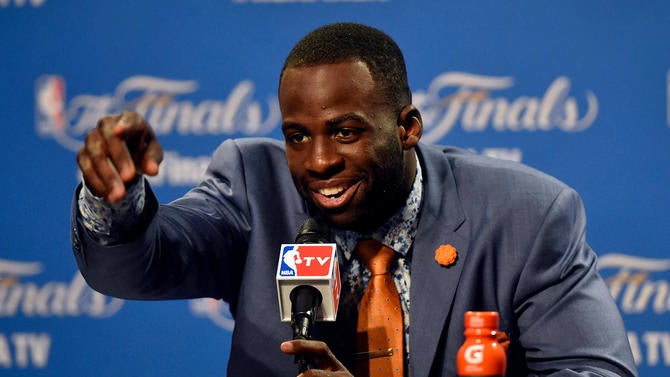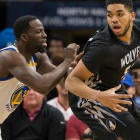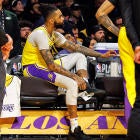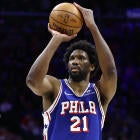Welcome to Coach Assist, a series in which some of the game’s best players will be examined through the lens of some of the game’s sharpest minds. The first installment features Ron Adams’ insight into the genius of Draymond Green.
Ron Adams is often called a defensive guru. The Golden State Warriors assistant coach could also be described as an appreciator of the finer points of basketball. He sees great players as artists, and when he expounds on the many defensive gifts of Draymond Green, the admiration is unmistakably genuine.
Adams, 69, said he’d be hard-pressed to come up with anybody more versatile or focused than Green, the front-runner for Defensive Player of the Year. He called Green’s ability to guard multiple positions and dominate fourth quarters “astounding.” Green’s approach, he said, is “simple at its core, but it becomes spectacular in its essence.” To him, this is not unlike Stephen Curry’s brilliance with the ball in his hands. A virtuoso is a virtuoso.
“I view sport as a form of poetry in many ways,” Adams said. “And defense has its own rhythm and poetry and beauty to it. It’s not always the part of the game that people can see that kind of grace and beauty and so on. And power. But I do think it captures it well.”
Green’s game might not always look elegant. On defense, he is almost always the loudest man on the court and often the most physical. He invades offensive players’ personal space and tries to make them uncomfortable. Of the league’s All-Stars and Olympians, no one better embodies the spirit of a role player fighting for a roster spot.
His story, how Green rose from the No. 35 pick in the draft to one of the biggest personalities in the NBA, has been told many times over, but it wouldn’t have been possible without continued dedication to all the small, unglamorous things that got his foot in the door. To the understated, self-deprecating Adams, Green’s all-out intensity on the court is a requirement for success. His technique, though, is what sets him apart.
“He definitely is an artist in his own realm,” Adams said. “And graceful and powerful and thoughtful. Because you can’t be a good poet or a good artist without being thoughtful.”

A teacher at heart, Adams believes that “all of us can improve at anything” in the right situation. In Green, though, he sees a special ability to read the game and anticipate what his opponents will do. Players can watch film and try to emulate the best defenders in the league, but few will ever be able to think like him.
“He’s just innately a focused, aggressive player who really, I think, sees the pictures of the game earlier than most,” Adams said. “And that allows him defensively to be an actor rather than a reactor to situations.”
Sometimes Green will reference plays that opponents ran the previous season as if they happened the night before. When it comes to other players’ tendencies, his knowledge base resembles a 10-year veteran’s rather than that of someone who is only in his third season as a full-time starter.
“He’s got good recall, not only during a game but digging up things from the past,” Adams said. “But I think he allows himself to do that by simply, for the most part, living in the moment, really being focused in the moment. I think that’s who he is. That’s how he thinks. That’s how his mind works. Everyone’s mind doesn’t work that way.”
Adams said that what makes Golden State excellent on defense -- versatility -- can also be tough on its players. Since Green and his teammates switch so often, they sometimes find themselves guarding a variety of different players on a single possession. This requires the Warriors to communicate and be connected. Green, maybe more than anyone else in the league, must be aware of where his teammates are and what they’re trying to do, plus all the strengths and weaknesses of everybody on the other side. It might look like he is just playing harder than everyone else, but he’s also constantly making calculations.
Whenever an opponent takes a shot, it’s a moment of truth for Adams -- did the Warriors defend well enough on the possession to adequately challenge it? Green and Knicks big man Kristaps Porzingis are the only players in the league who rank in the top-10 in contested 3-point shots and the top-15 in contested 2-point shots. He’s also second overall in deflections. Numbers confirm that he is flying around the court, but doing so with a purpose. The way he covers ground is so pleasing to Adams that it sounds like he’d like to step back every once in a while and watch him from a different vantage point.
“You have a lot of people who just love basketball and they keep watching these guys and I think they marvel at them in a way that is different than how we marvel at what they do simply because they’re more detached and they’re looking at it from the standpoint of a helicopter and we’re down in the trees, we’re down in the thick of it,” Adams said. “You try to enjoy the beauty of the game, the beauty of the athletes playing for you … but you’re also stuck in the fight.”

Adams wanted to coach Green back when he was on Tom Thibodeau’s staff with the Chicago Bulls. They had a defense-first identity, and he thought Green would fit right in after four years at Michigan State.
“We loved his upside, but in terms of what he brought, we thought he was a player who could play immediately,” Adams said. “He had kind of a crude game, not a polished game, but so many things were in place that indicated that he was going to be a really good pro basketball player, at least in our minds.”
Instead, the Bulls front office selected Marquis Teague with the No. 29 pick in the 2012 draft. A couple of seasons later, Teague was out of the league and Adams was on Steve Kerr’s coaching staff in Golden State. When Green got his big break because of an injury to David Lee, his ascendance was “pretty profound, and it was pretty immediate,” Adams said. When they won the championship, they did it with the 6-foot-7 Green starting at center.
“A defensive player like Draymond, a team player like Draymond can really affect the course of a franchise,” Adams said. “And he’s certainly helped do that here.”
Other coaches and executives have been looking for their Draymonds ever since. He and the Warriors showed the league how a Swiss Army knife guarding all five positions can be even more valuable than a behemoth protecting the paint. At times when Green has struggled with other parts of his game, Adams has reminded him that all he really has to do is be himself.
“I say, ‘Draymond, you’re a unique person. In your lane, there’s no one like you. And it’s important that you understand that,’” Adams said. “What he does sometimes is the work part of it, the redundant part of it to some people, but it is, to me, it’s just like the essence of being a winner.”

It might be a strange image, this professor of basketball partnering with one of the most aggressive and emotional players in the league. Adams loves the joy that Green takes in getting stops, though, and their shared dedication to that art form has led to an understanding.
In their three years together, Adams has seen all of Green’s ups and downs. There was the halftime screaming match in Oklahoma City, the suspension during the Finals. There were also all sorts of accolades, triple-doubles and game-saving plays. The two of them have a good rapport, partially because they can both be blunt in their assessments and adamant about their beliefs.
“He coaches me and I coach him,” Adams said. “And by that I simply mean he is, to me, a coach on the floor. Especially at the defensive end of the floor. He also does things at the offensive end of the floor that are special, but we’re talking defense now. He has the ability to analyze the game, he has strong opinions about the way things should be done. There are times that he wants to amend what we’ve proposed to do, and that’s something that I accept.”
Green isn’t afraid of pulling teammates aside and instructing them during games. Adams said “he can step on people’s toes” sometimes, but has become a much better leader than he was three years ago. In fact, Green is so invested in helping his teammates that Adams would be surprised if Green didn’t find himself in Adams’ shoes eventually.
“He’s going to be a tremendous coach,” Adams said. “I think he wants to coach. He’ll probably have to modify a little bit, and certainly age will do that for him, but he’s going to be an extremely, extremely talented coach. And again, I think those traits that he has in that regard serve him very well now -- this budding coach kind of mentality that he does have, that he brings to a game.
“He’s a basketball nut,” Adams added. “He loves the game. He studies the game.”
Picture this: In a decade or so, Green is on the sideline. Maybe he’s still in the Bay Area, maybe he’s back in East Lansing. He’s wearing a suit, maybe expressing a difference of opinion with an official, and still, of course, completely tuned in to the rhythm of the game.
“The thing that makes you great can never leave you, and the thing that makes him great is his drive and the dynamic nature of how he does things,” Adams said. “When you’re that kind of a player sometimes you can ruffle people’s feathers, but so be it. That’s who he is.”






















